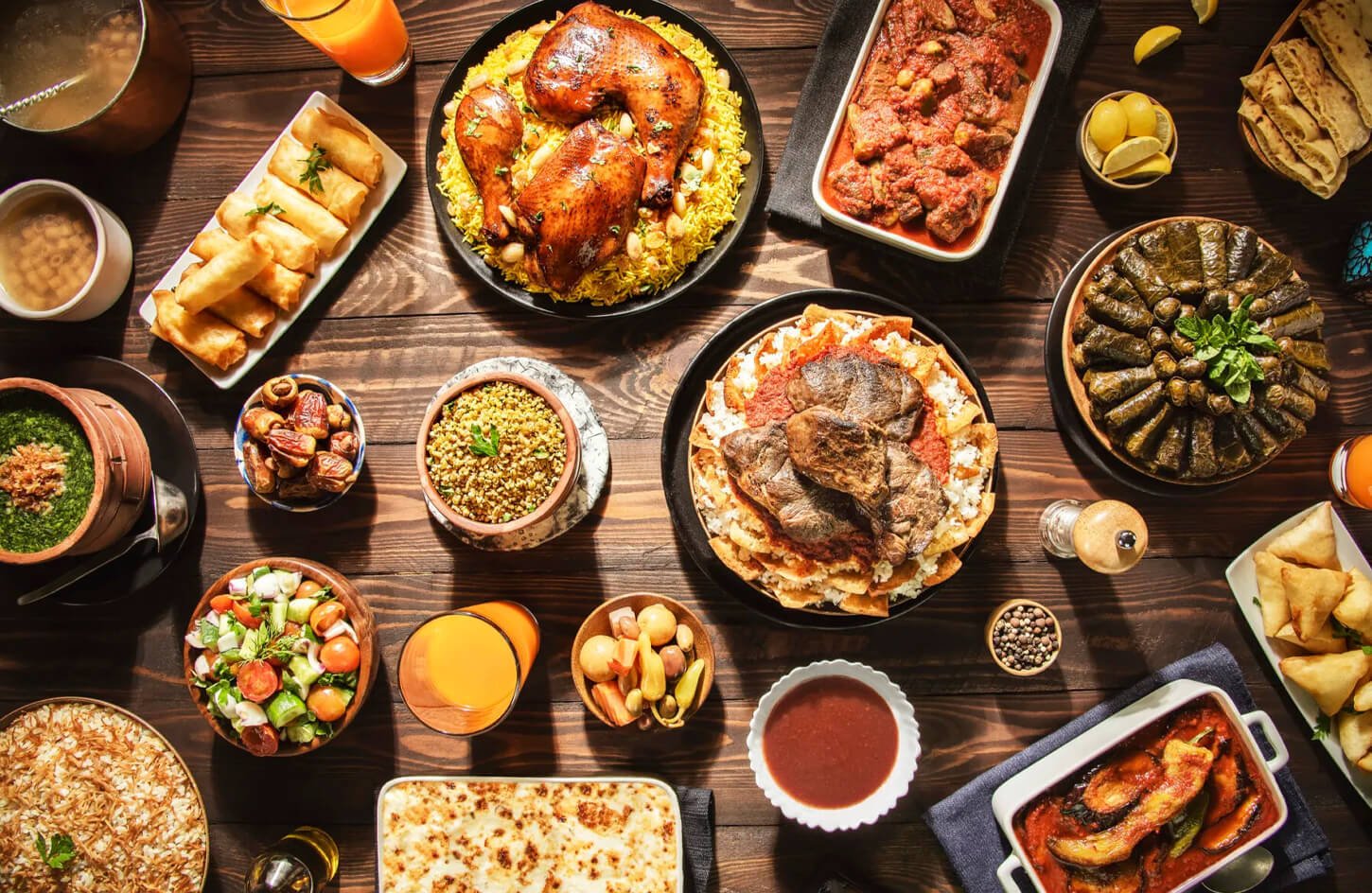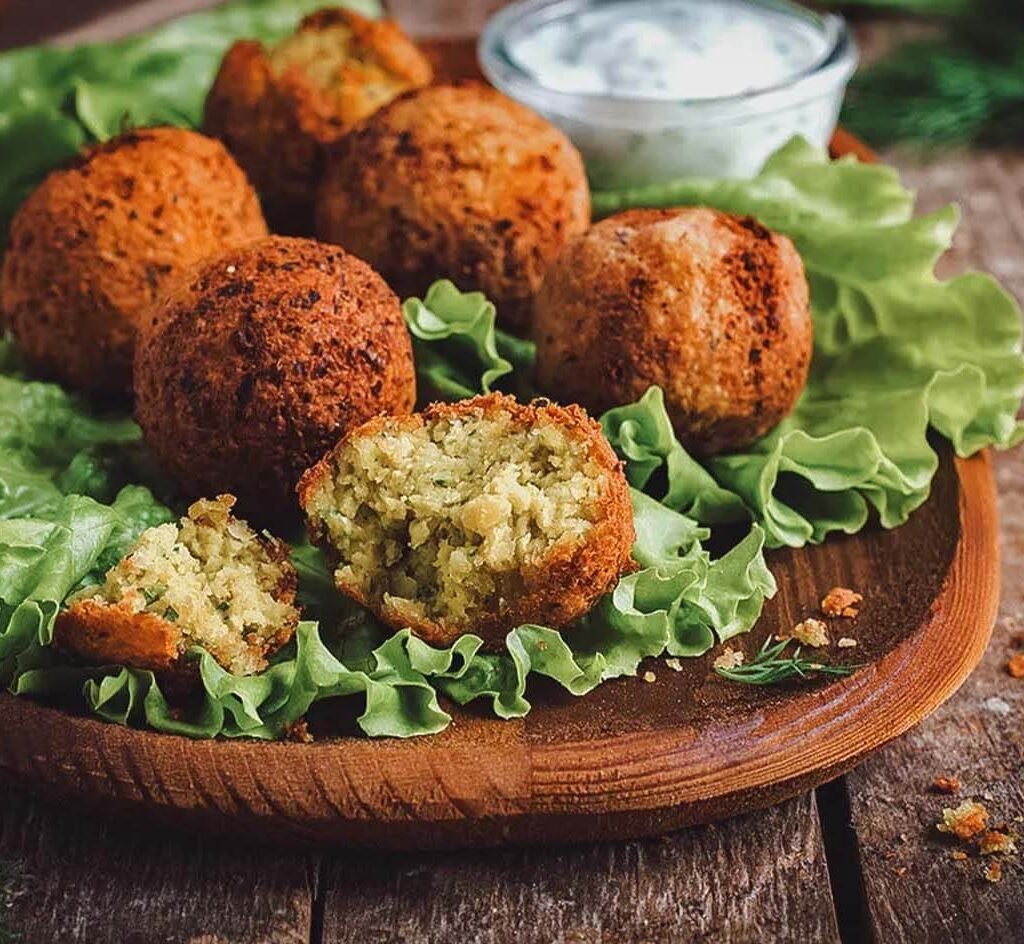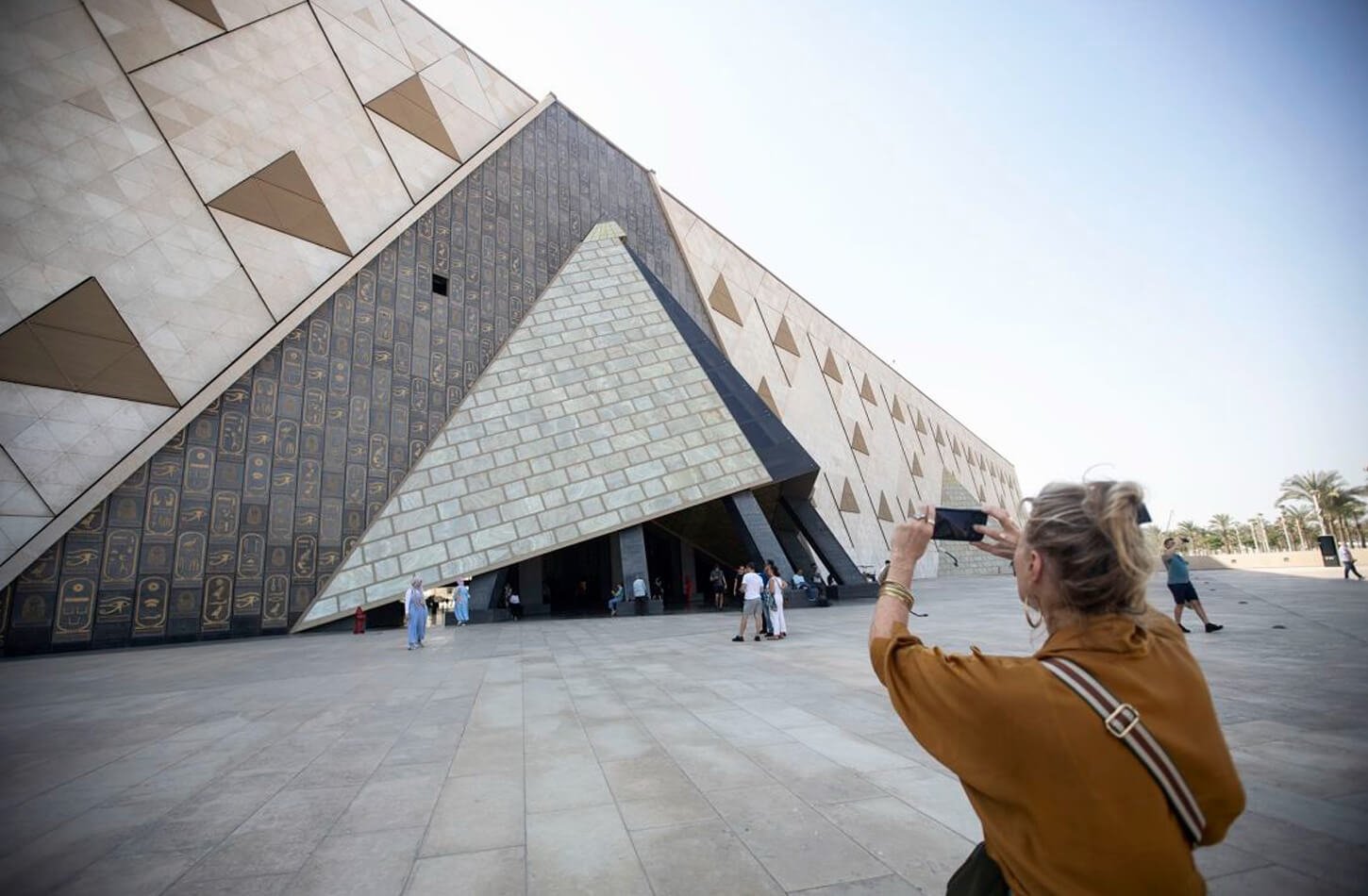
Imagine the smell of aish baladi filling Cairo’s streets. Street vendors add crispy onions to steaming bowls of ful medames. This is the essence of Egyptian cuisine.
I’ve spent years enjoying this food. From molokhia under the Nile’s light to debating koshari with locals. It’s history you can taste.
Every bite of traditional Egyptian food tells a story. Ancient grains, Roman spices, and Ottoman sweets blend in dishes like taameya falafel or rose-scented basbousa. Whether it’s sugarcane juice by the pyramids or mint tea etiquette, this guide reveals Egypt’s table soul.
Let’s explore the Nile’s legacy, one street cart or family feast at a time. Ready to discover why Egyptians say “khalas al-hawa” (the air feels right) when sharing meals? This isn’t just a menu—it’s a passport to 5,000 years of flavors waiting to surprise you.
When I first learned about Egyptian food, I was amazed. It goes back over 4,500 years, to the pharaohs’ time. They used emmer wheat for bread and beer, just like today in ful medames, a fava bean stew from 2500 BC. This food is more than just meals; it’s a window into Egypt’s past.
Real Egyptian dishes focus on simple yet strong ingredients. Fava beans, rice, and aish baladi (the “bread of life”) are key. Spices like cumin and coriander, brought by the Silk Road, make koshari—a rice, lentil, and pasta mix—very special. Even desserts like om ali, a nutty bread pudding, show the mix of cultures.
Vegetarianism is a big part of Egyptian life. With 70% of dishes being plant-based, it reflects Coptic Christian traditions and Nile Valley farming. Street vendors offer crispy fried okra and dukka, a spice-nut mix that’s becoming popular worldwide. Trying these flavors is like tasting history. Every bite links you to the past, from pyramid builders to medieval traders.
In Egypt, every kitchen has a few key ingredients. Start with aish baladi, the whole-wheat bread baked daily. It’s perfect with dips like baba ganoush or ful medames, the nation’s breakfast staple of slow-cooked fava beans. These dishes are loved for generations.
Spices like cumin and coriander warm up dishes from street-food ta’meya to kushari. Samna, or clarified butter, brings flavors together in stews and sweets like konafa. These basics are essential for authentic Egyptian recipes. Cairo’s spice markets are filled with cumin seeds and coriander, adding to the aroma of grilling kababs.

Legumes are a must: fava beans are in breakfasts and street carts, while lentils are in stews. Vermicelli noodles add texture to kushari and desserts. Eggplant is used in dips and moussaka, showing its versatility. When shopping, choose whole grains and fresh herbs like parsley, which top almost every dish.
These ingredients are more than just ingredients—they’re the heart of traditions. Learning to use them opens up Egypt’s culinary world. Whether making ful medames or enjoying sobaya salads, every bite shares a story of the Nile and centuries of cooking wisdom.
Imagine biting into crispy taameya—Egyptian falafel—stuffed with fava beans, not chickpeas. This popular Egyptian dishes list starts with koshari, the nation’s soul food. It’s a layered mix of pasta, lentils, rice, and tangy tomato sauce topped with crispy onions.
I’ve seen locals enjoy it at street carts and fancy restaurants. It shows how much everyone loves it.
Molokhia, a velvety green soup made from jute leaves, is another must. It’s earthy and rich, a flavor adventure for first-timers. Pair it with aish beladi, the airy whole-wheat bread baked daily in communal ovens.
Don’t miss baba ganoush, made creamy with roasted eggplant, or ful medames—slow-cooked fava beans spiced with garlic and lemon. Both are breakfast staples, served with olive oil and chili sauce.
Street vendors and historic eateries like Le Pasha—floating on Cairo’s Nile—offer traditional Egyptian food in memorable settings. Try mahshi: vine leaves or cabbage stuffed with rice, simmered in tomato broth. For meat lovers, shawarma wraps with cumin-rubbed meat are a quick, flavorful fix.
And savor bissara, a thick soup of mashed fava beans with cumin, perfect with warm bread.
These dishes are more than meals—they’re gateways to Egypt’s history and culture. From the Nile’s banks to bustling souks, every bite tells a story. Ready to taste Egypt’s soul? Start here.
Imagine the smell of garlic shawarma at dawn, the zing of lemon falafel, or the scent of koshari. Egyptian street food is more than a meal; it’s an adventure for your senses. My first taste of koshari in Cairo’s Sayeda Zeinab district was unforgettable. For just 50p, you get a mix of rice, lentils, and crispy onions, a dish loved by Egyptians for ages.
This affordability is what makes it special. Even the fanciest Egyptian restaurants can’t match the charm of sharing a paper cone of ful medames or crispy ta’ameya with a vendor. They know your order before you say it.
Street vendors are like storytellers. Their carts, between ancient mosques and modern malls, offer more than food. They show us daily life. A medium koshari at Abu Tarek costs 50p, while a “Golden Man” extra-large bowl is 80p. These prices let you try without spending a lot.
Compare this to eating at top best Egyptian restaurants, where the same dishes cost ten times more. Yet, both worlds exist together. Street stalls offer real authenticity, while restaurants make traditions elegant.
Eating like a local is a joy. Street food vendors are experts, like the woman in Islamic Cairo who taught me to drizzle garlic sauce over feteir. Every bite has a story. So, sit at a sidewalk cart, let the flavors surprise you, and join a conversation that’s lasted for millennia. The Egyptian street food scene is not just affordable; it’s where Egypt’s culinary soul comes alive, one crispy onion topping at a time.
Walking through Cairo’s Khan El Khalili bazaar, you’re surrounded by the scent of spices. Vendors sell pyramid-shaped baladi bread, dried apricots, and thick molasses. This is where Egyptian cuisine comes to life, filled with laughter and mint tea.
Begin at the spice rows. Coriander, cumin, and fenugreek spill from baskets. Ask for a custom koshary spice blend. Look for roasted tiger nuts and try salah, a spiced coffee. Each ingredient has a story, from the Nile to ancient trade.
Explore the produce stalls next. You’ll find warm fava beans and sun-dried tomatoes. Fishmongers show off Nile perch, and mangoes are sliced thin. Local breads like aish merahrah and ta’ameya show Egypt’s affordable and resilient diet.
Talk to shopkeepers about their favorite foods. They might give you a date with walnuts, a family tradition since the 1920s. Bargain with a smile, but let curiosity lead. Buying here supports traditions that fed pharaohs and street vendors.
Learning to cook like an Egyptian isn’t just about following recipes. It’s about mastering techniques that make dishes come alive. After years of learning from Cairo’s home cooks, I’ve seen how a few key methods can turn simple ingredients into delicious Egyptian dishes.
Start with slow cooking. Think of ful medames, Egypt’s national breakfast. Simmer fava beans with garlic and lemon until they’re soft. Use a Dutch oven or slow cooker for this.
Next, try grilling over dry heat. Shape team falafel into thick patties and sear them in a skillet. For kofta meats, char the edges to get that street-stall smokiness.
Layering is crucial in dishes like kosher. Use al dente pasta, creamy lentils, and crispy fried onions. Taste and adjust seasoning as you go, as Egyptian cooks do. Even without a clay pot, your stovetop can make molokhiya stew velvety. And don’t forget to roast—stuffed mahshi vegetables need gentle oven baking.
You don’t need every traditional ingredient to succeed. Substitute molokhiya greens with spinach if needed. These techniques unlock the soul of dishes like feteer meshaltet, with its flaky texture. By mastering these steps, your kitchen becomes a portal to Cairo’s markets and family tables. Now go: your first homemade taamya or slow-cooked lentil soup awaits!
Egypt’s food traditions change with the seasons and festivals. During Ramadan, I saw how food changes with the year. Winter brings fresh strawberries from the Nile Delta, and summer’s mangoes from Ismailia’s orchards.
Religious holidays also mark the calendar. In Ramadan, vendors sell warm kunafa, a sweet pastry, as families break their fasts. At Eid, tables are filled with Kahk cookies, reminding us of joy.
Coptic Christians fast too, like before Christmas. They eat lentil soups and roasted veggies instead of meat. This shows their creativity in cooking.
Spring brings fiseekh, a salty fish dish for Easter. Summer’s sugarcane stands offer cool treats. Autumn’s markets feature sugarcane, making treats like basbousa.
Knowing the calendar lets travelers taste Egypt’s heart. Ask locals about winter strawberries or Easter fish. Every season offers a new taste of Egypt’s flavors.
Exploring Egyptian food means learning about their traditions. Start by using your right hand, as it shows respect. This is important when trying dishes like ful or harira. Enjoy the meal and let conversations flow.
At someone’s home, take off your shoes before entering. Always wait for your host to seat you. Accept any tea or coffee with thanks.
When you like a dish, say it’s fantastic instead of asking if it’s good. This shows you appreciate the effort. Leave a small amount of food on your plate to show you’re full.
Be mindful of your body language. Don’t point your feet at others, as it’s seen as rude. When sharing food, use your right hand. And while alcohol isn’t common, bringing sweets is a nice gesture.
Showing gratitude is important. Say “shukran” (thank you) or “mashallah” (God willing) when praised. These small actions make meals more than just food—they’re cultural experiences.
When I first tasted koshary in New York City, I was surprised. It had vegan cheese or spicy chili drizzles. This showed me Egyptian flavors are getting a new twist abroad.
From coast to coast, chefs mix tradition with local ingredients. They turn popular Egyptian dishes into hits for everyone. Imagine maharishi grape leaves with quinoa or fava bean Tamiya in crispy croquettes. These updates keep the dish’s soul while appealing to American tastes.

In Chicago and LA, restaurants try new things with classic dishes. Think Fiteer, Egypt’s buttery filo pizza, with smoked salmon or goat cheese. Even full, a simple breakfast dish, gets a modern spin: in spreads for avocado toast or with labneh yogurt.
The best Egyptian restaurants now showcase these new takes. Diners can try dishes like shakshuka-inspired bamya (okra stew) or kofta with harissa glaze. These dishes bridge two culinary worlds.
Kunafa, a beloved dish, isn’t left unchanged. Chefs add dark chocolate or matcha, while Miami street vendors offer fahsa (stuffed pigeon) as gourmet sliders. This fusion is more than taste—it’s about keeping heritage alive while welcoming new fans.
Next time you see “macaroni bil bechamel” on a menu, try it with truffle oil. You’ll see how Egyptian flavors evolve yet remain true to their roots.
Egyptian cuisine is more than just food. It connects ancient traditions to today’s tables. Each spoonful of Koshari or Ful Medames brings history alive, passed down through generations.
My travels in Cairo’s markets showed how these dishes are still loved today. 60% of Egyptians enjoy Ful Medames every day, showing its lasting charm.
Spices like cumin and coriander, once traded along the Nile, now spice meals in places like Baltimore. Chefs there make vegan versions of classics. Hawawshi, a street food, also adapts while staying true to its roots.
These dishes are more than meals. They are stories of resilience and joy, woven into a cultural fabric.
Imagine sharing Iftar with 90% of Egyptians during Ramadan. Or joining 70% of families for picnics during Sham el-Nessim. Festivals like Eid, where Fattah is on 80% of tables, show how food brings people together.
Even in modern kitchens, slow-cooking and using seasonal ingredients reflect ancient ways.
Exploring Egyptian cuisine is like tasting history. From the Nile to Baltimore’s menus, every bite tells a story. Whether it’s mint tea with 75% of households or Umm Ali at a festive table, you’re part of a long tradition. Let these flavors guide you—Egypt’s culinary legacy welcomes you to savor, learn, and connect.
Read more related articles:







Don't just get there, get there in style.
Information
Follow Us
Payment channels
